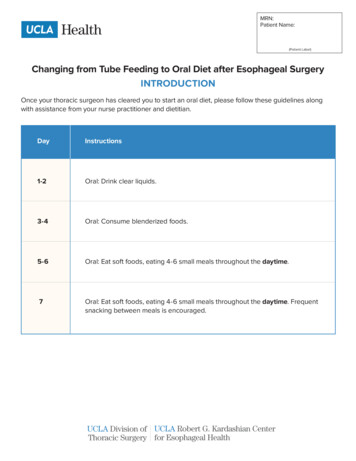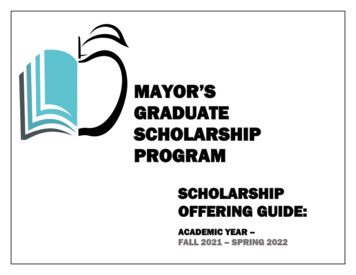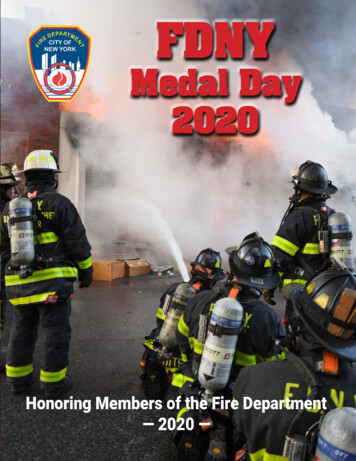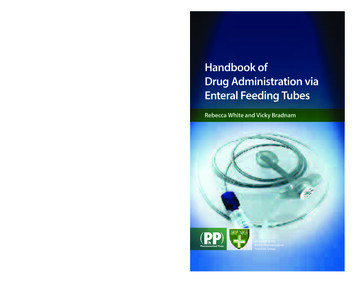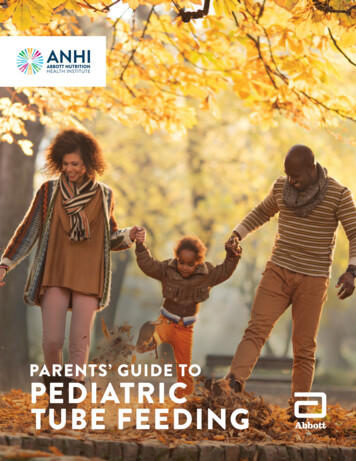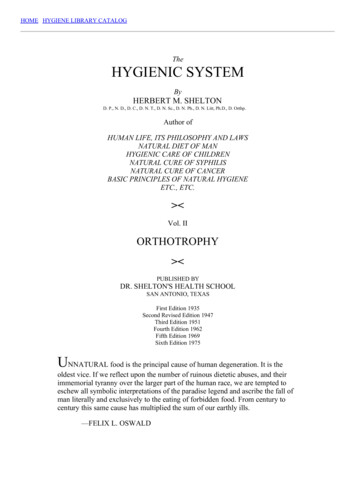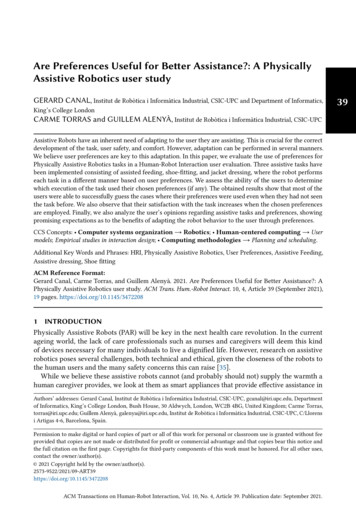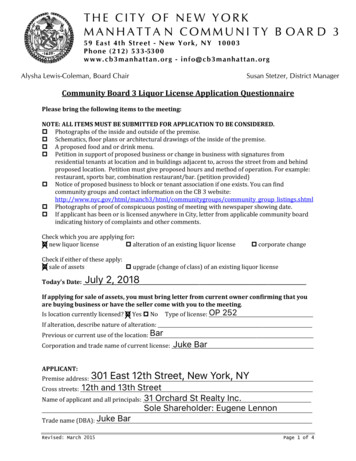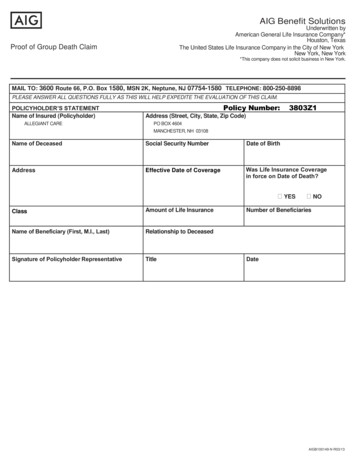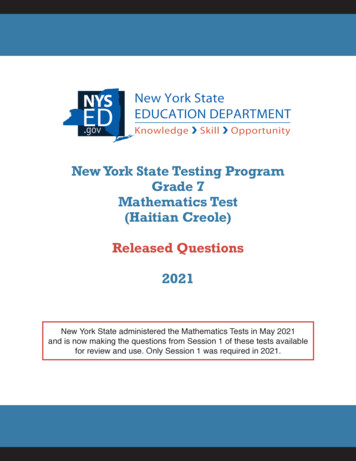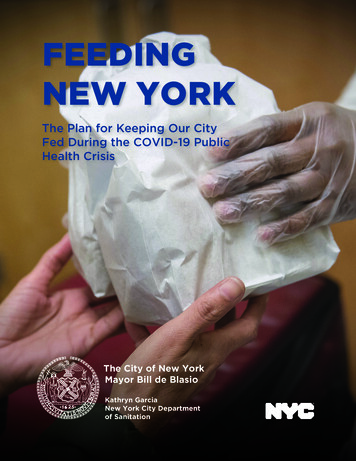
Transcription
FEEDINGNEW YORKThe Plan for Keeping Our CityFed During the COVID-19 PublicHealth CrisisThe City of New YorkMayor Bill de BlasioKathryn GarciaNew York City Departmentof Sanitation
2Feeding New York:The Plan for Keeping Our City Fed During the COVID-19 Public Health Crisis
Table of Contents4.Message from the Mayor5.Commissioner’s Message7.Introduction11.Phase 1: Meeting Immediate Needs17.Phase 2: Medium and Long-Term Responseand Building Food System Reslience21.Beyond Feeding New YorkFeeding New York:The Plan for Keeping Our City Fed During the COVID-19 Public Health Crisis3
Message from the MayorDear New Yorkers,As we fight COVID-19 in our hospitals, our economic crisis grows, too.As more and more New Yorkers lose their jobs and are faced with financialuncertainty, we will not let New Yorkers go hungry.In March, I appointed Commissioner Kathryn Garcia to be our city’s FoodCzar, a cross-agency effort to ensure we get food into the hands of anyone inneed and that our food supply remains strong. We will spare no resource tomake sure this is done right.This is a plan to put food into the hands of every New Yorker who needs it asthe economic crisis deepens. The City has never done anything on this scalebefore, because we’ve never been in circumstances so dire.But in the past few weeks alone, we’ve shown we can do things no one thoughtpossible.Just in the last month, from our DOE Meal Hubs at over 400 sites acrossthe City, to our home delivery program, we have served over 4.5 million freemeals.We’re delivering thousands of meals every day to seniors and homebound NewYorkers.Working with the City Council, we’ve also allocated millions in emergencyfunding to our food pantries and community kitchens to make sure theirshelves are stocked when New Yorkers turn to them.And all over this city, we are seeing the charity of communities of faith, ofbusinesses, and of individuals making a daily difference in the lives of our mostvulnerable.This is just the beginning. We won’t let anyone go hungry in the greatest city inthe world.New Yorkers are resilient, and there is no crisis that we cannot overcome. Wewill get through this together.Mayor Bill de Blasio4
Commissioner’s MessageHere’s what I know about New Yorkers: we thrive in a challenge, we don’t leaveeach other behind, and we love to eat. During the COVID-19 public healthcrisis, we are being tested on our ability to keep our city fed while still stayingsafe behind closed doors.This is a crisis unlike any other our city has faced. After Hurricane Sandy, afterthe 2003 blackout, and after 9/11, the directive was always the same: go outand celebrate the city we love, support our local businesses, and stand shoulderto shoulder with our heads held high. Today, our survival depends on doingprecisely the opposite - on staying away from one another, sequestered indoorsunless absolutely necessary. How do we do that while still ensuring that everyNew Yorker has enough to eat?In a city where 1.2 million New Yorkers faced food insecurity even before thiscrisis, and where hundreds of thousands may have recently lost their jobs,this is a daunting task. With support from the private and civic sectors, wewill make sure New Yorkers are fed whether this crisis lasts weeks, months, ormore, no matter how dire the situation may become.This plan covers our efforts to date, as well as preparations to build a safer,more secure and resilient food supply for the long-term. I encourage all NewYorkers in need to visit nyc.gov/GetFood for an evolving list of availableservices.We cannot let any New Yorker go hungry during this crisis. I look forward toworking with you on this important effort.Kathryn GarciaSanitation CommissionerNew York City COVID-19 Food Czar5
We won’t let anyone gohungry in the greatestcity in the world.Mayor Bill de Blasio6Feeding New York:The Plan for Keeping Our City Fed During the COVID-19 Public Health Crisis
IntroductionThe COVID-19 pandemic has created an unprecedented crisis in NewYork City. We are at the epicenter of a public health emergency that hasfrozen economic activity across the country, cast millions of Americans intounemployment, and sickened thousands of our fellow New Yorkers.The emotional and personal toll of this crisis is immense. It has createdeconomic challenges on a scale not seen in this country since the GreatDepression. And our City is responding in kind.Many New Yorkers, especially older New Yorkers and those with other healthconditions, are stuck in their homes. We will feed them.Hundreds of thousands of New Yorkers are newly unemployed, and theirfamilies are struggling to make ends meet. More than one million of ourneighbors experienced food insecurity before this crisis. Countless moreexperience it now. We will feed them.This is an unprecedented crisis, and we will meet it with an unprecedentedresponse. In the last three weeks alone, the City has provided approximately4.5 million meals to hungry New Yorkers. Our robust network of soupkitchens, food pantries and other community organizations are feedinghundreds of thousands more on a daily basis. In total, the City is investing 170 million over the next several months in this unprecedented effort tofeed New Yorkers.“Feeding New York” is the City’s plan to feed hungry New Yorkers throughoutthis crisis and protect the security of our food supply chain. Our approachbegins with immediate steps to secure our food supply chain and feed hungryand vulnerable New Yorkers. In the coming weeks, we will transition tothe second phase, preparing for evolving and growing needs and buildingresilience into our food supply.If any New Yorker needs a meal during this crisis, we will feed them.Feeding New York:The Plan for Keeping Our City Fed During the COVID-19 Public Health Crisis7
8Feeding New York:The Plan for Keeping Our City Fed During the COVID-19 Public Health Crisis
Food Insecurity in New York CityMany New Yorkers struggled with hunger and food insecurity before this crisis.Before our first COVID-19 case, 1.4 million New Yorkers relied on foodpantries and soup kitchens, and 1.2 million were food-insecure, including 1 in5 children. As the economic impact spreads, we know these numbers are risingevery day.The City is anticipating heightened need among: Youth ages 18-and-under, whose access to food is impacted by schoolclosures New Yorkers over age 60, including those who previously relied oncongregate meal programs at senior centers or home delivery via theDepartment for the Aging, as well as those who are now unable orunwilling to leave their homes New Yorkers with disabilities, who may have relied on caregivers nowimpacted by COVID-19 and the need for social distancing Non-citizens, who may not be eligible for federal benefits, services, orgrants Communities of color who are disproportionately affected by foodinsecurity and underlying health conditions due to structural racism, yetrepresent a majority of the food service workforce Low income populations including NYCHA residents and those served bythe Department of Social Services Hundreds of thousands of newly food-insecure people impacted by theeconomic downturn, including many who have never accessed governmentbenefits or support in the pastThese populations can be broken down into three groups: COVID-vulnerable,food-insecure, and those who are both. Each of these three categories willrequire different approaches to meet their specific needs around access to foodfor the remainder of this crisis.New Yorkers who are neither COVID-vulnerable nor food-insecure need tobe able to continue to access retail and restaurant food purchase and deliveryoptions.Feeding New York:The Plan for Keeping Our City Fed During the COVID-19 Public Health Crisis9
NYC’s Food Supply SystemNew York is perhaps the greatest “food city” in history, with cuisines andingredients from around the world. The vast majority of all ingredients sold inNew York City come by truck from across the United States. On average, 19billion pounds of food are distributed throughout New York City each year —more than 2,000 pounds per person. The City has a highly-distributed foodinfrastructure, with approximately 42,000 point-of-sale outlets, from five-starrestaurants to dollar slice storefronts, high-cost specialty wholesalers to cornerbodegas. Many of these outlets know the needs of their communities and haveproven highly adaptable.Heading into this crisis, New York City had the advantage of a safe and securefood supply. Unlike in some other cities, where the majority or totality of thefood supply comes through a single point of entry, New York’s supply chain isspread throughout the five boroughs. The largest single point-of-sale location,the Hunts Point Market area, accounts for 13 percent of all incoming food.New York City also has the benefit of a world-class labor workforce, includingfood manufacturers, grocery store workers, neighborhood delivery drivers andlong-distance truck drivers. Farmers and farmworkers in the broader area nearNew York City are also an essential foundation for the urban food workforce.Our essential workers are being tested by this crisis, and we must ensure that atevery step of the chain from farm to service, they are safe and supported.Our ApproachThe work of feeding New Yorkers during this crisis must be grounded in anequity model, and built upon an awareness of existing structural imbalancesin our food system. Access to food is a fundamental human right. All NewYorkers should have equal ability and opportunity to access nutritious,affordable food in their communities.As we execute this plan, we are committed to providing meals that not only arenutritious, but are also culturally and ethnically appropriate. The connectionbetween food and individual health is clear and are committed to doingeverything we can to ensure that what we source is healthful. We will developdistribution models to specifically address areas that already lack access tohealthy and fresh food options. Additionally, we hope to utilize as many NewYork City producers and businesses as possible.We also are committed to ensuring that all of the workers along our foodsupply chain, especially those working in grocery stores and food marketsacross the entire city are supported. Now more than ever, the role of the peoplethat grow, produce, prepare, and sell our food is essential.10Feeding New York:The Plan for Keeping Our City Fed During the COVID-19 Public Health Crisis
Phase 1: MeetingImmediate NeedsSince the start of the COVID-19 crisis, the City has provided approximately4.5 million free meals to hungry New Yorkers, taken key steps to secure theCity’s supply chain, moved to shore up the food pantries and organized andexpanded food availability to our most vulnerable residents.Feeding New YorkersFeeding New York:The Plan for Keeping Our City Fed During the COVID-19 Public Health Crisis11
12Feeding New York:The Plan for Keeping Our City Fed During the COVID-19 Public Health Crisis
Keeping Food Pantries StrongNew York City has a network of more than 800 food pantries and emergencyfood providers, ranging from some of the nation’s largest food banks to smallneighborhood churches and community organizations. The City is supportingour food pantries, many of which relied on volunteers who are themselvesCOVID-vulnerable. We have coordinated donations to pantries in need,shifted resources to pantries able to operate with social distancing protocols inplace, and provided direct staffing support to keep pantries open. On April 10,New York City announced 25 million in funding to support emergency foodproviders that have experienced increases in demand as well as increased costs.Many neighborhood farmers markets are still operational and serve a vital foodaccess role for both New Yorkers as well as the region’s farmers. A list of manyNYC Green Markets can be seen at grownyc.org, although neighborhoodsmay have other farmers markets as well.Grab & Go Meals at NYC SchoolsEvery weekday, over a million students receive free breakfast and lunch. TheCity has expanded the school meals program to serve all children and adultsin need. Any New Yorker can get three meals per day on weekdays at 435locations in all five boroughs.Since March 16, we have distributed more than 3 million meals to childrenand adults at our schools. In the coming weeks, DOE will expand to offerKosher meals (Halal is already available) as well as multi-day pantry boxes forpickup on Fridays, to better serve families for the weekend.To support food-insecure populations, a map of DOE Grab & Go sites andopen food pantries is available at nyc.gov/GetFood.Feeding New York:The Plan for Keeping Our City Fed During the COVID-19 Public Health Crisis13
Map of all sites as of 4.14.20 (note: map changes daily and can be seen atnyc.gov/GetFood)Emergency Food Home DeliveryFor New Yorkers who are both COVID-vulnerable and food-insecure —particularly low-income New Yorkers over age 60 and those with other healthrisks — the City has implemented an emergency home delivery option. Topromote the program, we have reached out to the populations most likely toneed the service, including completing robo-calls to over 400,000 seniors andoutreach to NYCHA and affordable senior housing residents.Since March 24, the NYC Emergency Food Home Delivery program hasdelivered more than 1 million prepared meals to New Yorkers with the greatestneed. Deliveries are currently available six days per week, and each deliveryincludes four meals for up to two residents per household. Currently, over11,000 TLC-licensed drivers have signed up to make these deliveries, and wecontinue to expand our capacity to meet the growing demand. Anyone whomeets the program criteria can sign up at nyc.gov/GetFood or by calling 311and saying “Get Food.”14Feeding New York:The Plan for Keeping Our City Fed During the COVID-19 Public Health Crisis
Senior Meal DeliveriesIn mid-March, the Department for the Aging (DFTA) began transitioningall congregate meal programs at more than 240 senior centers into deliveredmeals, to protect this vulnerable population. This delivery program has servedapproximately 300,000 meals to seniors who previously ate meals in groupsettings. The City is rapidly expanding senior meal deliveries through theNYC Emergency Home Delivery Assistance program. Seniors can sign up formeal deliveries at nyc.gov/GetFood or by calling 311 and saying “Get Food.”Protecting our Supply ChainSupporting Food Retailers and Small BusinessesThe supply chain that brings food and other goods into New York Cityremains strong. As panic buying has slowed and consumer habits are settlinginto a new norm, our primary focus is supporting food retailers and the foodsupply workforce. At the same time, we are monitoring and intervening asnecessary at critical points in the supply chain, and preparing strategies tosecure the supply chain long-term if needed.To remind New Yorkers to be safe and respectful while shopping, we are usingNotifyNYC alerts and LinkNYC hubs. We have distributed posters on socialdistancing to grocery stores across the five boroughs, and have encouragedshoppers to wear face coverings. Stores can mandate that all customers mustwear face coverings. We have also encouraged grocery stores to implementsenior-only hours.Feeding New York:The Plan for Keeping Our City Fed During the COVID-19 Public Health Crisis15
We are helping to connect large food businesses with PPE manufacturersand working to donate PPE to smaller grocery stores in highly-impactedcommunities. Grocery store workers and other essential employees are eligibleto receive free childcare at our Regional Enrichment Centers. As restaurantshave transitioned to takeout and delivery only, the City has suspendedenforcement on usage of electric delivery bikes, and has worked with the foodservice sector to ensure that restaurants offering takeout food are practicingproper social distancing protocols.To support small businesses, the Department of Small Business Services hascompiled a number of financial resources, available here. We are expandingour workforce program to promote these resources to local grocery stores inneed, particularly in hard-hit communities including Sunset Park, Flushing,Elmhurst, and much of the Bronx. In many of these communities, there maybe food in the stockroom, but workforce challenges have kept it off the shelves.The City will support businesses in finding workers and is developing a newcase management system for this express purpose.Maintaining Critical Transportation NetworksNinety percent of our food supply comes into the City via long-haul trucking.In order to support the hard-working drivers delivering our food, we havecreated two new truck rest areas, where drivers can safely take federallymandated rest breaks. These sites are located adjacent to critical parts ofthe food distribution system: at Hunts Point Food Distribution Center inthe Bronx, the largest food distribution hub in New York state, and GlobalContainer Terminal in Staten Island, the largest container port in New Yorkstate.16Feeding New York:The Plan for Keeping Our City Fed During the COVID-19 Public Health Crisis
Phase 2: Medium andLong-Term Responseand Building FoodSystem ResilienceAs in all aspects of the City’s response to the COVID-19 crisis, we are hopingfor the best, and preparing for the worst. It is possible this crisis will continuewell beyond the current season, particularly for older New Yorkers, and wemust be prepared to provide food to those in need for months to come. It islikely that some programs may need to wind down or shift in shape, whileothers will need to expand.Feeding New Yorkers in the Long TermEmergency Home Delivery Assistance 2.0To meet the growing demand, the Emergency Food Home Delivery programwill continue to build capacity to better serve our communities. We areworking with NYCHA, HPD, and nonprofit agencies to identify buildingswhere the entire or significant majority of residents need assisted home mealdelivery, so that we can meet the needs of the entire group, without requiringevery resident to enroll in the program.In the coming weeks, case managers, community-based organizations,and City agencies will be able to directly enroll clients in meal deliveries,troubleshoot issues, and submit re-order requests as needed. This will ensurethat all New Yorkers, including those without regular internet access, can beconnected with meals.As the program continues to grow, we will monitor food demand trends, driveravailability and areas of increased need. Future phases of this initiative willbuild upon lessons learned in the initial phase, providing an opportunity toconsider new models for large-scale feeding operations.Food Access ProgramsFederal funding is essential to addressing the needs of the food-insecurein the City in the short, medium, and long term. The City fully supportsexpanding access to federal food assistance programs to reach more NewYorkers, including through Pandemic Electronic Benefits Transfer (P-EBT),Feeding New York:The Plan for Keeping Our City Fed During the COVID-19 Public Health Crisis17
a program that would cover all public-school children in New York City. Inaddition, we are seeking to increase benefits for recipients of federal foodassistance programs, such as the Supplemental Nutrition Assistance Program(SNAP), pursuing waivers to give Special Supplemental Nutrition Program forWomen, Infants, and Children (WIC) recipients more flexibility in stores andat farmers markets, seeking added funding for the Child Nutrition Programand the Senior Nutrition Program, and requesting additional support for foodbanks from the state and federal governments. Emergency food providers playa critical role in supporting food benefit access and enrollment. In order tomeet the growing need, we will expand outreach and support organizations toprovide enrollment support.The City is also advocating for a substantial increase in funding for theEmergency Food Assistance Program for food banks, and we support federalfunding for grocery stores to meet projected staffing challenges. The City ofNew York fully supports a federal stimulus package that provides hazard payfor essential workers, including food supply chain workers, and increasedsupport for essential businesses.As this crisis continues, we will partner with other cities, states, and foodadvocates across the country to form a national campaign to promote morefederal support for vital food access programs, such as SNAP and WIC, andrebuild the nation’s food safety net. The pandemic demonstrates the needfor reforms to federal agricultural policy to support small farmers as part of aresilient, equitable, and sustainable food supply for New York City.18Feeding New York:The Plan for Keeping Our City Fed During the COVID-19 Public Health Crisis
Reinforce and Strengthen our Food Supply SystemHelping Businesses and Customers Adapt to UncertaintyRestaurant closures and shifting consumer preferences have createddisruptions, including excess supply in certain product categories. We willdevelop partnerships and tools to connect suppliers directly with unmetdemand, aggregating supply and demand via existing and new platforms,including through collaboration with upstream regional suppliers and farmorganizations. However, consumers may see significant changes in whatfood items are on the shelf at their local grocery store. The City will conducteducation campaigns around how to adapt recipes and eating habits to thisnew reality while maintaining a healthy, hearty and affordable diet, and assistlocal businesses in supporting consumer needs.A Changing Food IndustryThe restaurant sector is a critical part of our food system. While temporaryclosures have had many consequences, private sector groups such as WorldCentral Kitchen and Rethink Food NYC are actively leveraging restaurantassets to serve and deliver meals via a community kitchen model. We willintegrate the restaurant industry into our efforts, building capacity forculturally-competent meal preparation in neighborhoods across the city forthe duration of this crisis.In the intermediate to long term, New York City will pursue additionalopportunities to support increased wages, benefits, and protections foremployees across the food supply chain, as well as innovative and cooperativebusiness models for food businesses to ensure long term economic resiliency.Regional Infrastructure and ManufacturingThis crisis has shown us the need to protect and expand our manufacturingzones to ensure capacity for food processing and refrigerated food storage,and the ability to process wholesale products to be supermarket-ready forretail. We are seeking to strengthen our existing industrial assets and retrofitindustrial spaces for new food manufacturing uses quickly. In support ofthis effort, we will develop training resources for our local workforce to takeon food processing work typically done outside of the City and expeditecertification for this training at the state and federal level. In the long term,we will work to allow for a wider range of food-related uses in our IndustrialBusiness Zones (IBZs) to allow for co-development of cold storage, processing,and packing facilities.We will also seek to develop regional food sector programs to support theCity’s ambitious sustainability goals in this challenging time. To buildresilience of supply and distribution in market and emergency channels, wewill support the food processing, reuse and manufacturing sectors to scaleup our regional food production. This may include working with partnersoutside New York City to provide technical and financial support forFeeding New York:The Plan for Keeping Our City Fed During the COVID-19 Public Health Crisis19
regional agriculture, with a focus on the farms, processing infrastructure anddistribution hubs.Distributed Transportation InfrastructureFlexible and multi-modal freight distribution makes us more resilient. NewYork City will continue to advance initiatives like FreightNYC in partnershipwith other local, state and regional entities, to build a safer, more efficient, andmore sustainable local transportation and delivery infrastructure. For longhaul transportation, we will work to secure the supply chain links betweenfood production areas and New York City, and explore modal options fortruck, rail, and maritime transport. Building out rail and barge capacity helpsensure multiple options for food flow while reducing climate emissions fromthe transportation sector. For our last-mile infrastructure, we will seek to pilotcargo bike delivery services and allow for more mixed-use industrial activity tosupport more localized, dispersed and sustainable distribution centers.Planning for Supply Chain DisruptionWhile we remain confident that our food supply chain remains strong, it ispossible that temporary disruptions in production, transportation, storage,distribution or sale could create short-term supply shocks in the New YorkCity region. While this remains unlikely, we are taking steps to proactivelyprepare for the worst-case scenario. The City is allocating funds in the budgetto ensure we have a sufficient runway to ramp up additional food supply anddelivery for food-insecure New Yorkers. These funds ensure there is additionalsupport for the activities of the food team over the coming months, includingclose monitoring of the food supply and an increase in food delivery to NewYorkers in need. The 50 million investment can fund 18 million shelf-stablemeals in reserve if needed in the future to adjust to any temporary disruptionsin local food supply or distribution infrastructure, and it will add to the300,000 meals ready-to-eat currently stored by New York City EmergencyManagement at warehouses in New York and New Jersey.20Feeding New York:The Plan for Keeping Our City Fed During the COVID-19 Public Health Crisis
Beyond “FeedingNew York”To respond to this crisis, we have moved quickly and built an unprecedentedfood delivery system to serve New Yorkers. We thank our non-profit foodaccess groups and local elected officials for their support. One of the mostimmediate lessons of the COVID-19 food response has been the clearopportunity for better integration and partnerships between the public,private and civic sectors. Our collaboration will lay the foundation for amore equitable City even beyond this crisis, as we build local and regionalpartnerships throughout the food supply chain and make structuralimprovements to the City’s food access network.Nonetheless, this crisis has revealed underlying food system challenges,including inequitable access to healthy and nutritious food. This crisis presentsan opportunity to rethink inequitable or outdated systems across our foodsupply. We are connecting New Yorkers to services who have never soughtpublic assistance before--and building a stronger, more resilient community aswe go.Any New Yorker in need should reach out for help at nyc.gov/GetFood. This issuccess: feeding New Yorkers, regardless of how long this crisis persists or howdeep it gets.Feeding New York:The Plan for Keeping Our City Fed During the COVID-19 Public Health Crisis21
nyc.gov
The Plan for Keeping Our City Fed During the COVID-19 Public Health Crisis Phase 1: Meeting Immediate Needs Since the start of the COVID-19 crisis, the City has provided approximately 4.5 million free meals to hungry New Yorkers, taken key steps to secure the City’s supply cha
